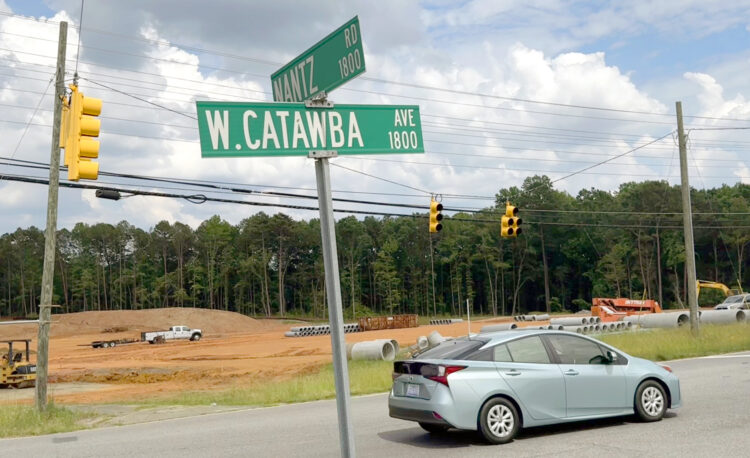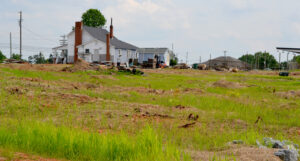
Construction on W Catawba and Nantz / Photo by Jason Benavides
June 12. By Dave Yochum. Question: Is there a tree preservation ordinance? Anything that actually prevents clear-cutting?
Susan Johnson, town commissioner, responds: “Unfortunately not at this time. We can make conditions to specific projects such as limiting the amount of trees removed based on a site plan that could address clear-cutting. I personally am not on board with clear cutting a site as there are all kinds of impacts on the ecosystem including wildlife displacement. We have started discussions with town staff on creating a sustainability committee for the town which may address how we handle clear-cutting for future projects.”

Johnson
Background
Clear-cutting and random tree removal without consideration for the tree canopy has been the norm in Cornelius for years. Witness the clear-cutting of two different sites on West Catawba—the Junker projec and a new mixed-use project at the foot of Nantz Road—not to mention the once-verdant Alexander Farm at Westmoreland.
Preservation efforts right now consist of turning a landmark tree felled on Catawba into lumber for a commemorative bench.
“Trees are valuable resources and provide so many benefits regarding shade and beauty in our natural environment. That is important to me,” said Mayor Woody Washam.
Background
It may be important to many people, but the preservation of the tree canopy runs up against private property rights.
Developers maximize their profits by getting as many units out of their land, which helps keep a lid on the price of new homes. Then, too, the “highest and best use” of land likely maximizes the potential of any given property, helping keep a lid on everyone’s property tax burden.
Chances are, the property under and around your home was clear cut by a developer.
Washam said Cornelius tree cover is about 44 percent, 4 points over the minimum established by the American Forests Association, but that’s going down with new development.
Cornelius adopted a new Land Use Plan in 2023 that limits types of uses, types of growth, specifically density minimization that will reduce tree clearing, with replacement standards noted. The Code also dictates required buffers and types of green space required in new developments.

Trees cleared from the Junker property
Development and tree removal are only permitted along existing road and street corridors. This is to limit the development and destruction of open space and forested areas off the corridors.
“Unfortunately, people only see what they drive by, and they assume jurisdictions allow mass removal of the tree canopy, when very often, that is not the case,” Washam said.
Then why is virtually every tree gone from large construction sites?
These projects were approved by previous boards with different priorities, including the generation of more tax revenue for the town.
Propert owners’ rights
New members of the Town Board might take tree protection a step further.

Wolfe
But it becomes challenging when anyone, including governments, try to say how a land owner should develop their property.
“This current board has rejected projects that would remove significant tree canopy. The most productive strategy is for the board to ensure that zoning and land use overlap, allowing the town to grow while preserving the unique aspects that make Cornelius such a special town,” said Commissioner Todd Sansbury.
Preservation
Paula Wolfe is a member of the town’s historic preservation committee. Trees could be part of local historic preservation efforts, she said, but it’s still early and just an idea. Building a coalition of tree lovers could help inspire some new tree regulations in Cornelius.
“There is absolutely a lot of interest in tree preservation now that we are losing them so rapidly. Animal habitats are also being impacted,” Wolfe said, calling the situation in Cornelius “a mess.”

Higgins
Agreeing that current rules and regulations around trees are vague, Mayor Pro Tem Scott Higgins said he is in favor of a “reasonably crafted ordinance that helps provide guidance for decision-making, likewise, a majority of the members of the Town Board.
It’s happening in other high-growth, suburban districts—Vienna, Va., for example, where a new ordinance will require anyone building on properties of at least 2,500 square feet to cover 10 percent to 25 percent of the property with tree shade. Developers who don’t meet this requirement can contribute to a newly established Tree Preservation and Planting Fund.
“This is exactly the type of measure we should study,” said Cornelius Commissioner Robby Carney.




